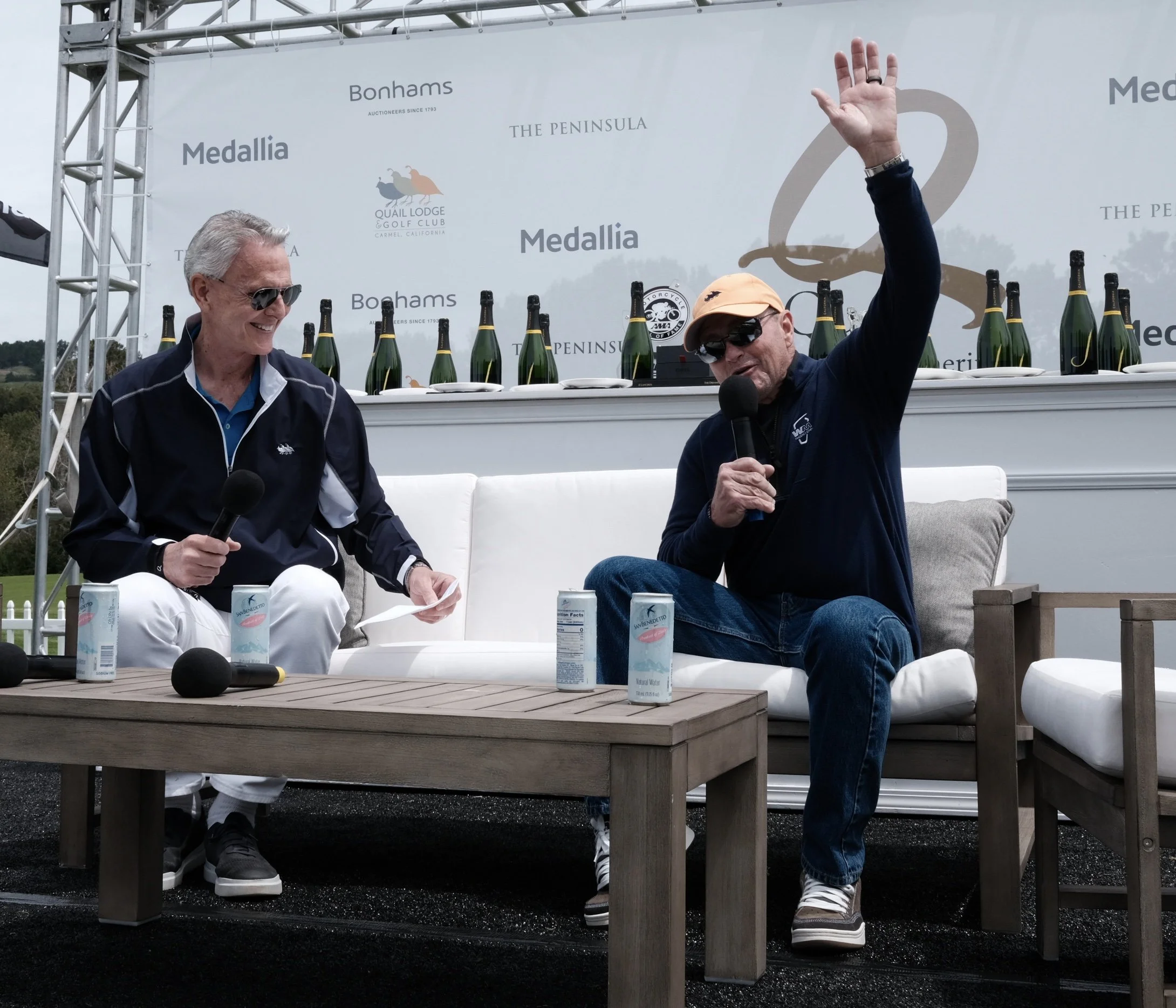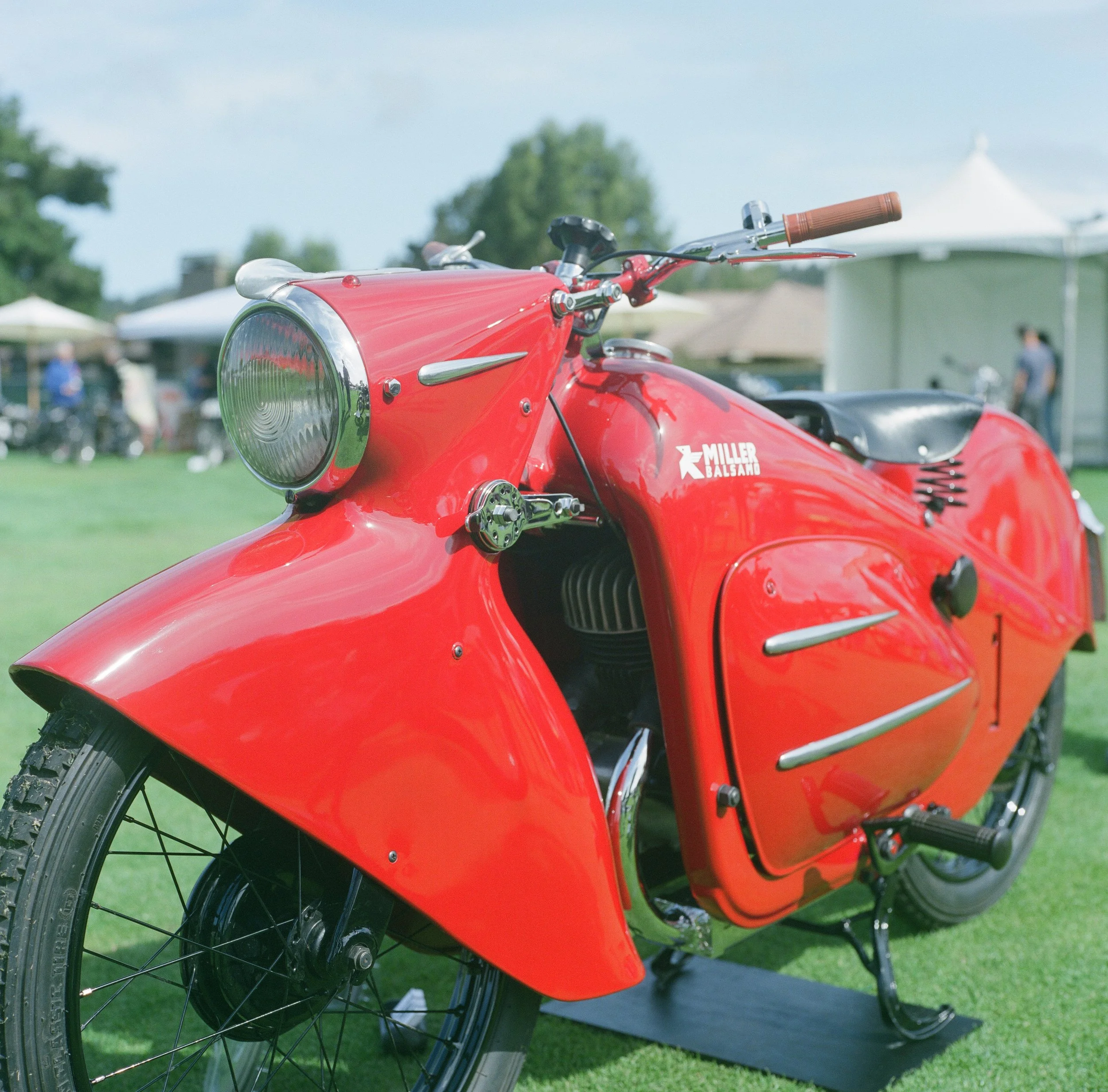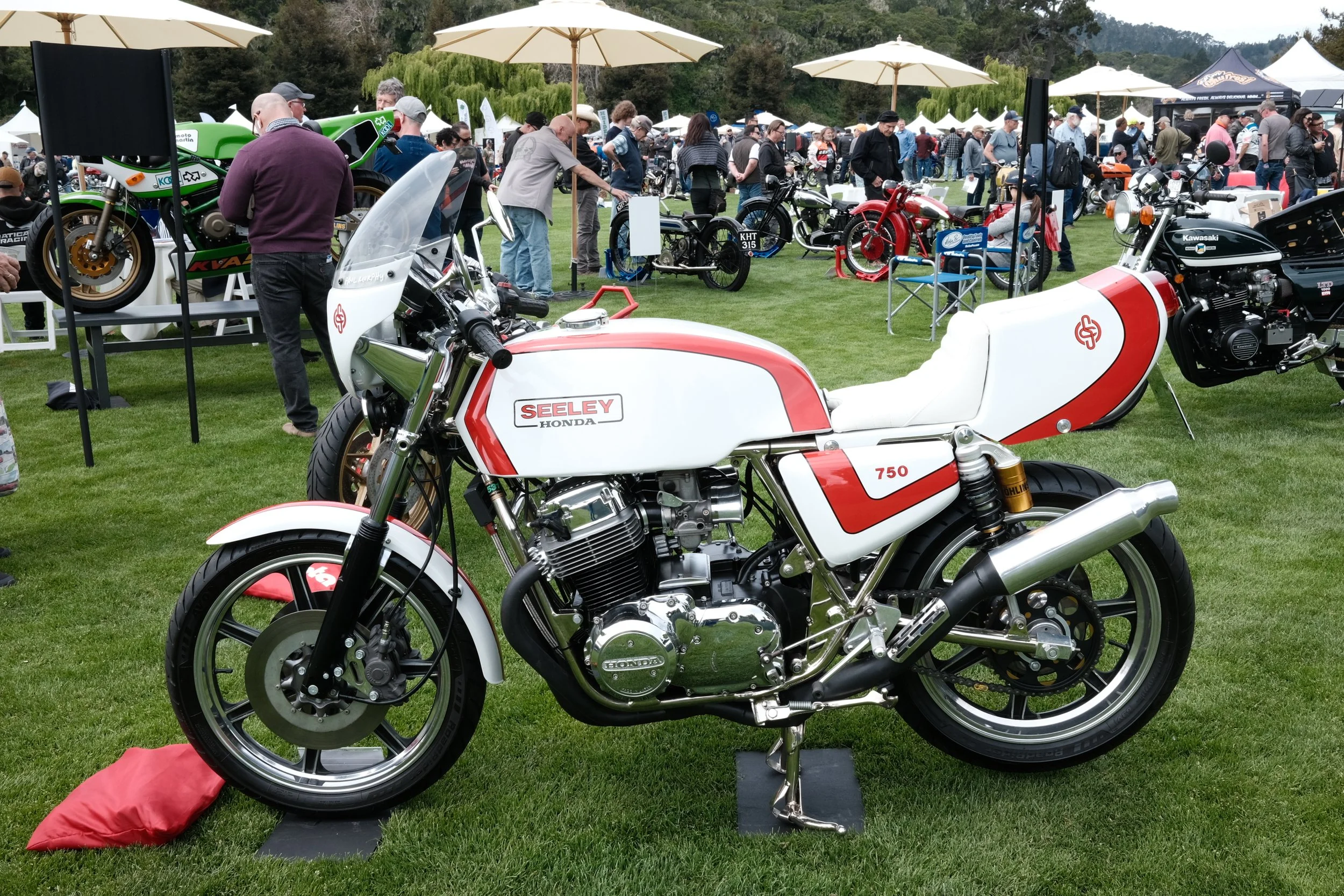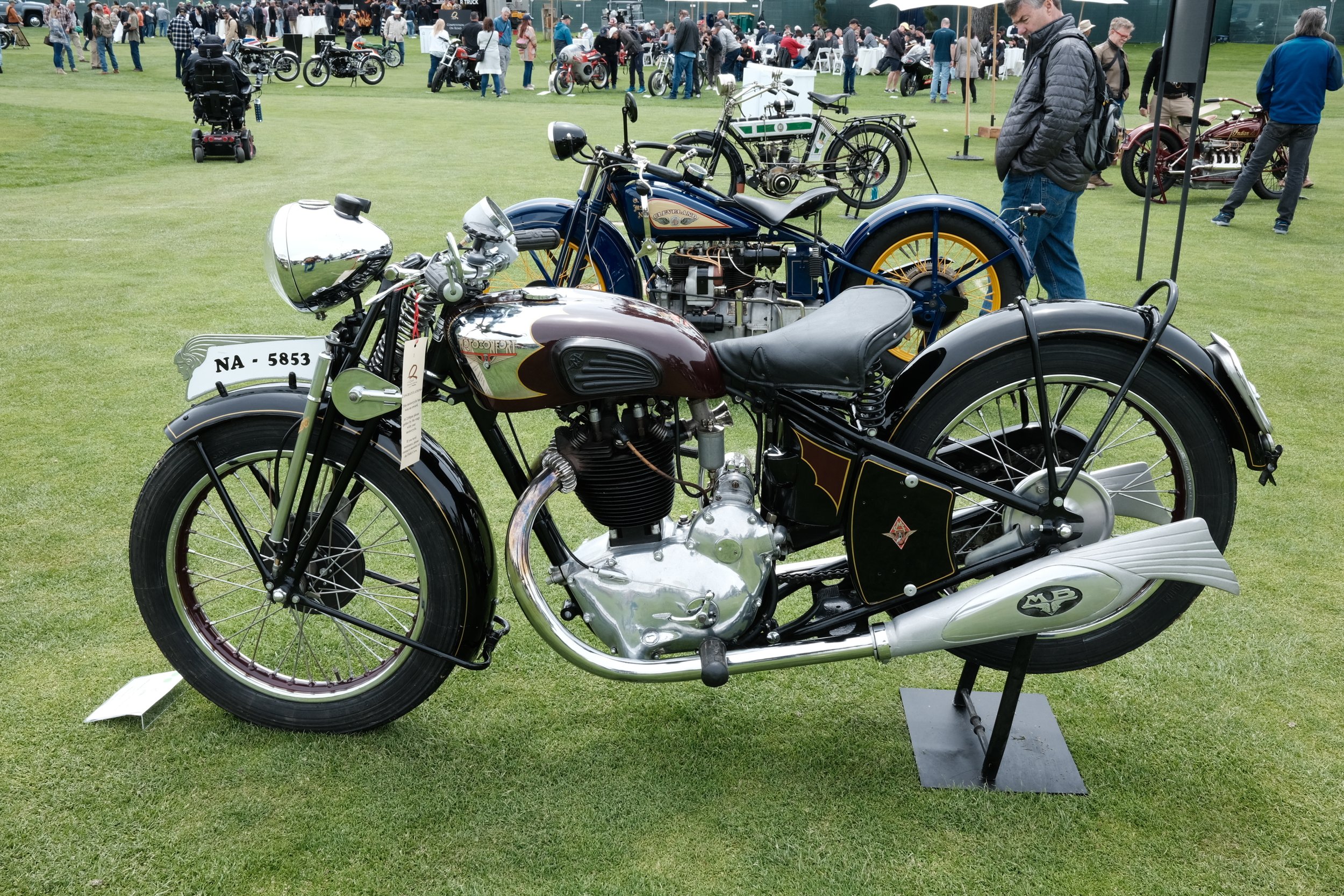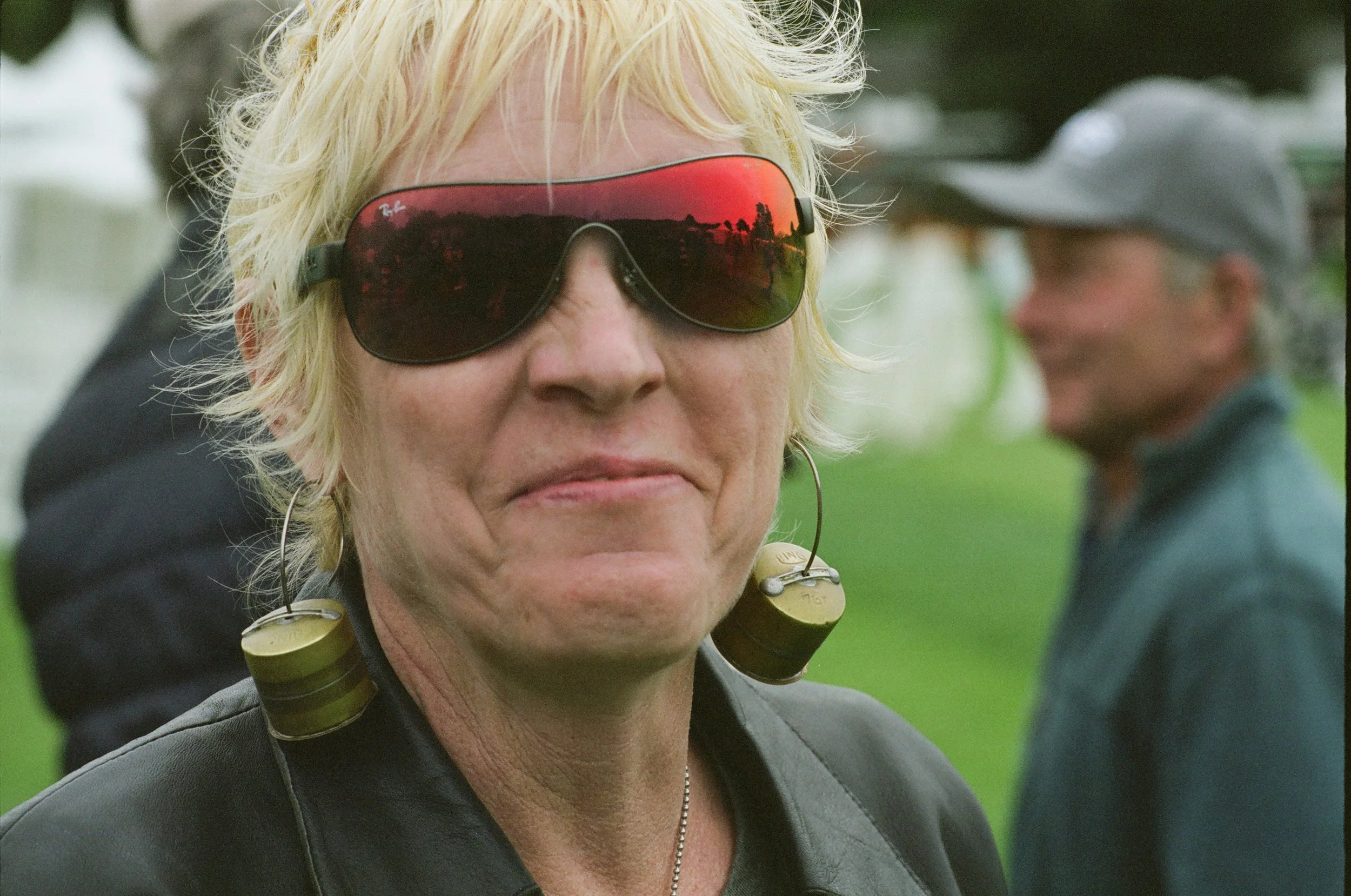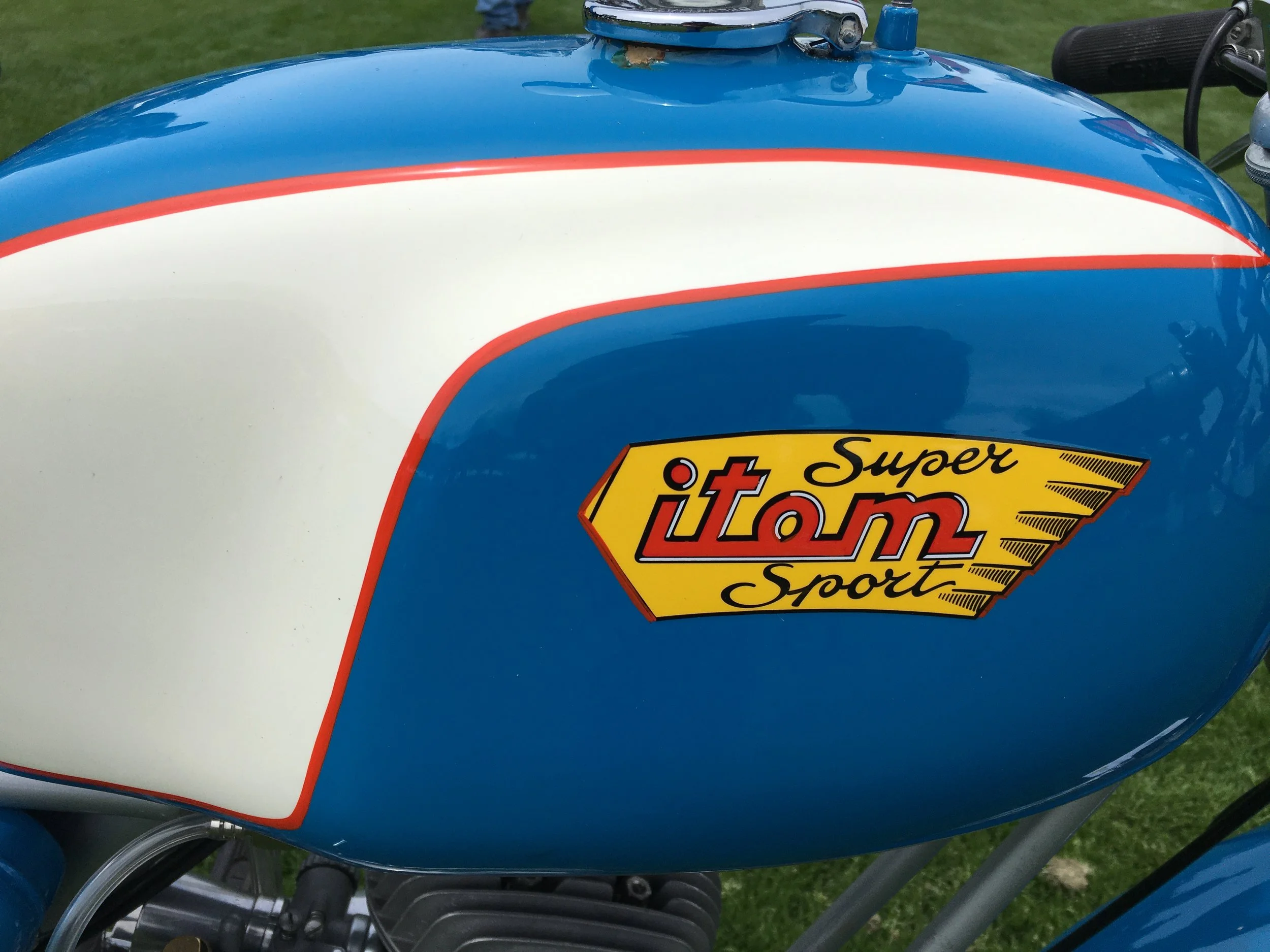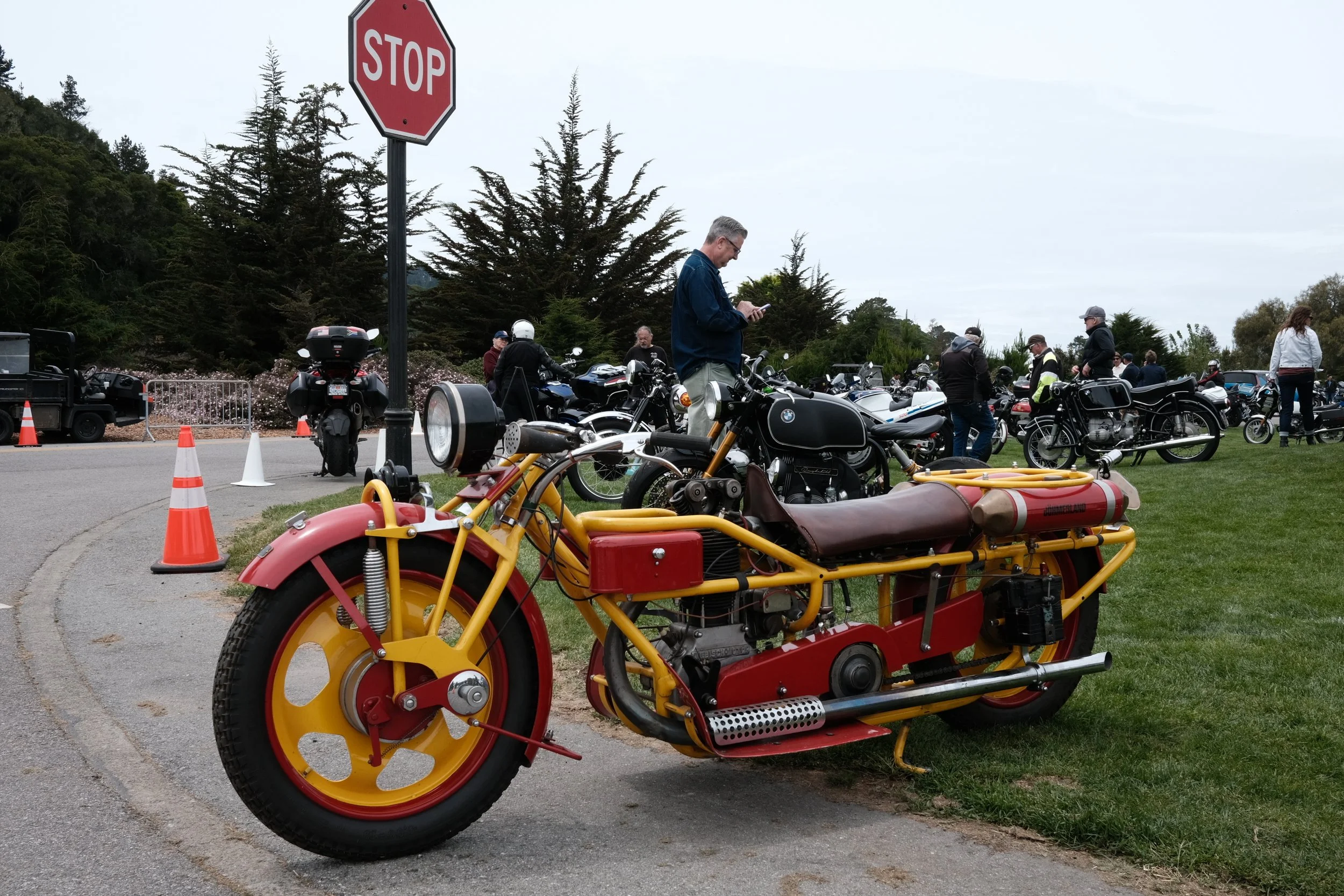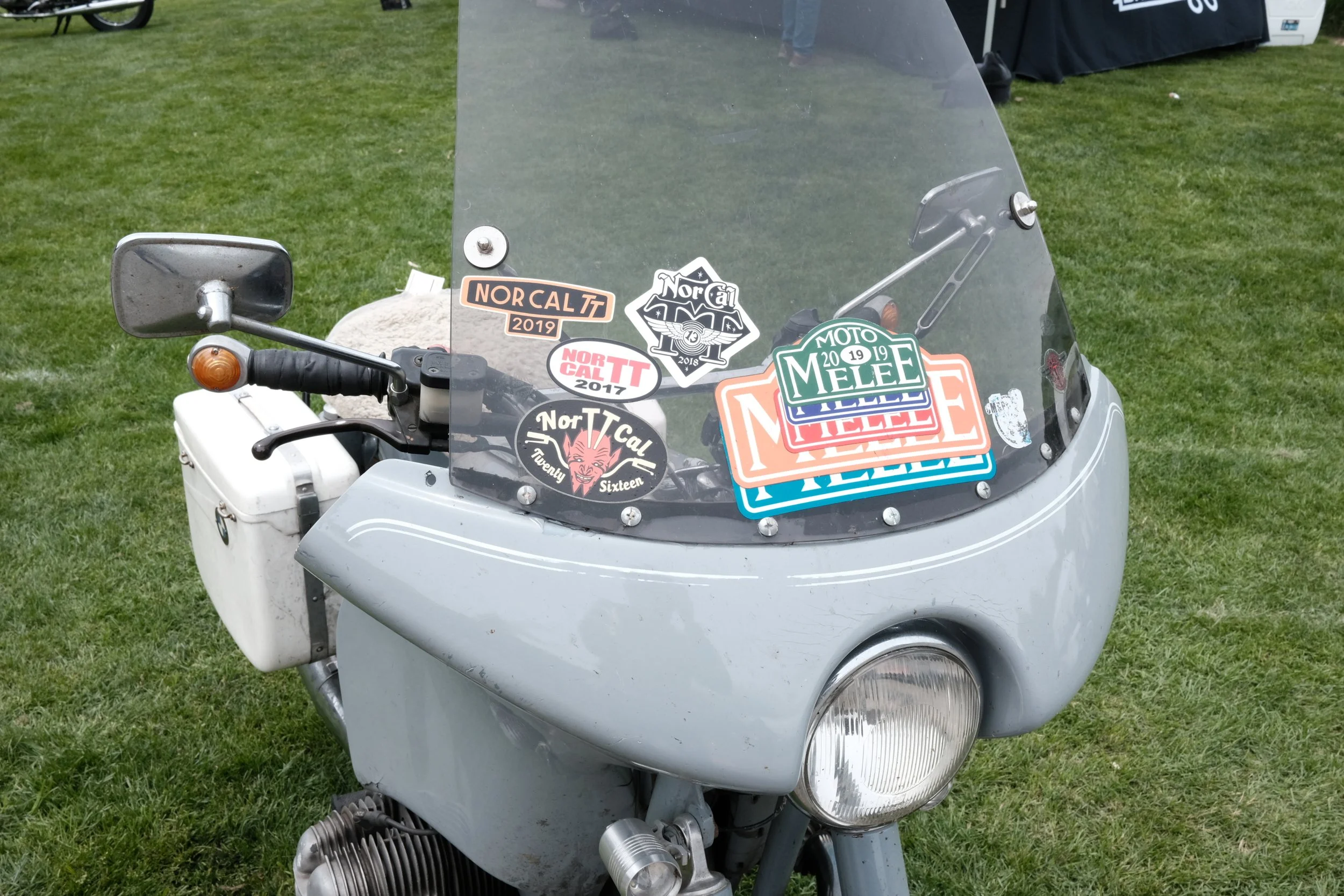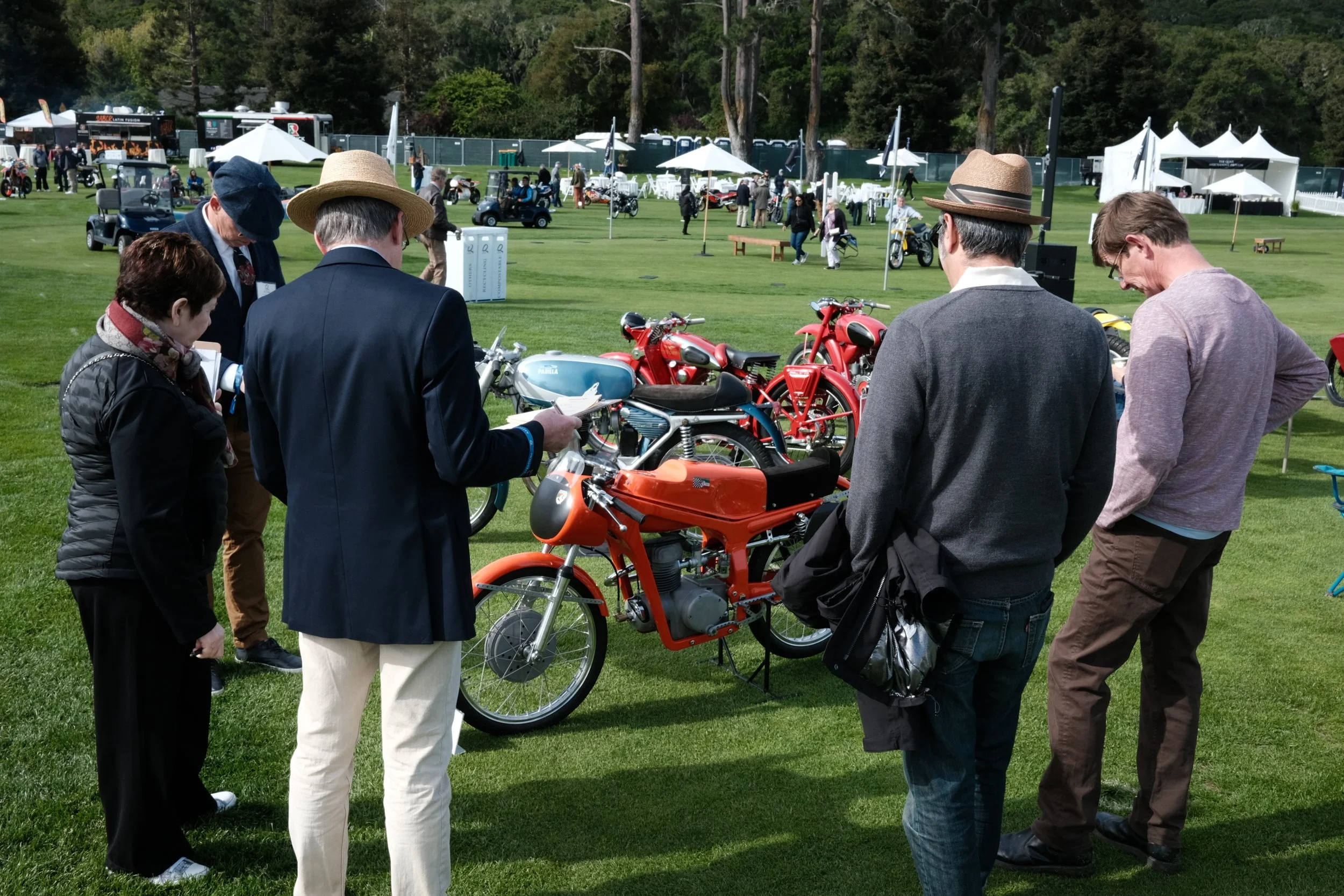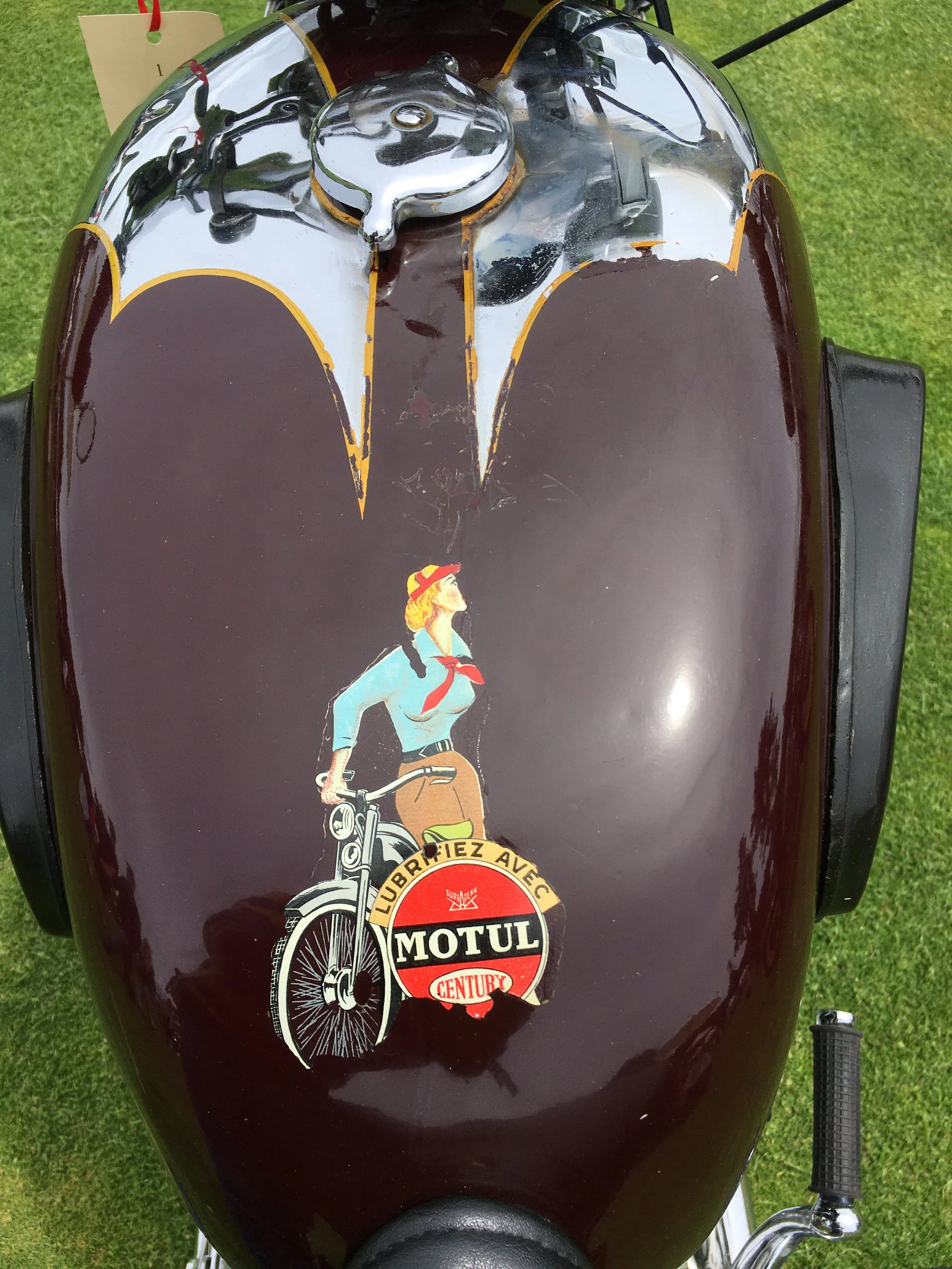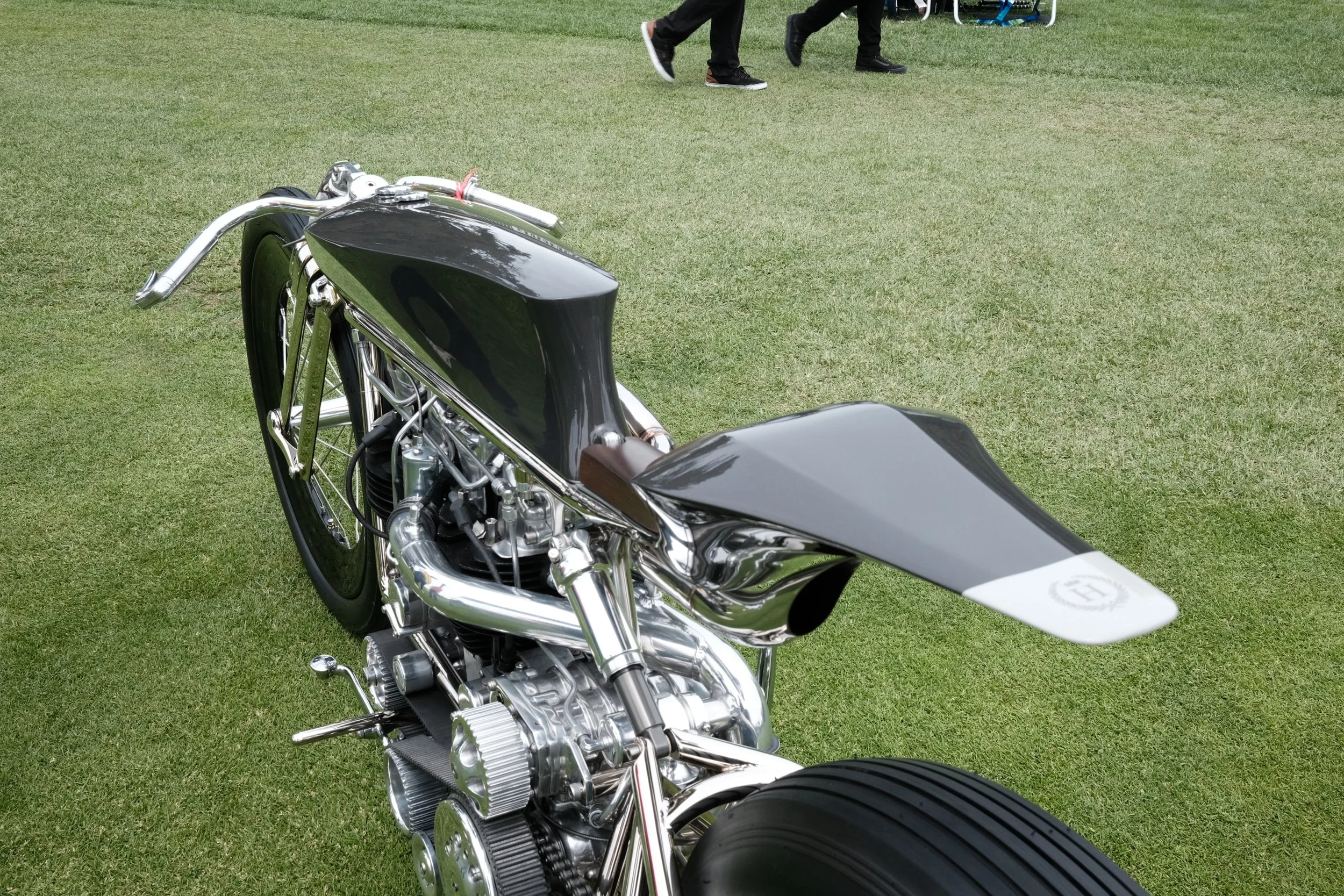Quail Motorcycle Gathering Number 13
This photo sums up the Quail Motorcycle Gathering for me. Amazing bikes (in this case a Vincent) and folks who are just gaga to check them out.
Words + Photos: Mike Blanchard
The weekend of May 6th saw the 13th edition of the Quail Motorcycle Gathering at the Quail Lodge & Golf Club in Carmel Valley.
The Quail, as it’s colloquially known, is a one-day concourse but the weekend starts off on Friday with the Quail Ride. Limited to 100 motorcycles, it takes in 100 miles of amazing roads around the Carmel and Salinas Valleys ending up at Laguna Seca for some parade laps. Afterwards there are dinners and gatherings and confabs at the lodge and the Cantina next door. In the Saturday morning fog the bikes are rolled out on the fairways and greens of the golf course and the judging begins.
This year the event was blessed with perfect weather. Given the recent weather on the Peninsula this was not guaranteed because there was a significant chance of rain in the cards. This may have discouraged some of the folks who were eyeing the Weather Channel from bringing their bikes, or attending for that matter. But if there were a few less bikes there were dividends in lower temps (Carmel Valley can get pretty hot in the afternoon), a slightly smaller crowd and a fantastic display of machines.
If shows like Born Free or One Moto are the rowdy cutting-edge of the moto world the Quail Motorcycle Gathering is the more polished end of the spectrum. Garnering a well heeled crowd and featuring a large number of rare and significant machines.
Robb Talbott’s immaculate Capriolo is a study in design and packaging. It won first prize in the inaugural Italian and Single catagory and the Spirit of the Quail award. Although that last award may have been for Robb himself more than the bike as he embodies everything the Quail stands for: style, class and enthusiasm for motorcycles.
It’s a crowd not afraid of, or embarrassed by, the term lux. Superstars of national and international racing like Wayne Rainey, Eddie Lawson and Bubba Shobert can be found casually talking with the crowd as they look over machines that have won championships both Grands Prix and domestic.
Just two cats having some fun. The Vintagent, Paul D’Orléans, and master craftsman, machinist and moto builder Max Hazan. D’Orléans has been the MC At the Quail Motorcycle Gathering for a number of years. He’s a popular and amazingly knowledgable (and patient) fixture on the scene. One day earlier he was in Italy riding. If you have not seen any of Hazan’s bikes, do yourself a favor and look him up. Minds will be blown.
In short, it is a selective bunch of bikes on display and, even considering the motorcycle class at the vaunted Pebble Beach Concourse, it is arguably the most dazzling moto spectacle on the West Coast. California is blessed with many luminaries of the motorcycle world, from collectors, restorers, designers and custom builders to the aforementioned racers and industry titans like Craig Vetter and Paul D’Orléans. The Quail is the show where serious collectors of historic machines and high-end custom builders come out to show their best and debut their new creations.
There are probably more BMWs year after year at the Quail than any other marque. A tribute to what great bikes they are.
The bikes are grouped by judging class which gives a nice sense of organization to the show. This year there were three new classes added to the 11 previous classes. Bring On The Baggers, ‘70s Vintage Muscle, and Italian and Single joined American, British, Japanese, European, Antique, Off Road Competition and custom/modified classes. All three of these segments have seen a lot of interest and subsequent collecting growth in the last few years.
Around the display area were tents featuring the sponsors, club and vendor displays. And there were interesting and significant bikes at almost every tent. The Velocette Owners Club had a great display of vintage racing and road machines with club members on hand to talk all things Velocette.
The folks at Quail lodge put on a quality, polished event as one would expect. During the day there were interesting discussions with promotor Gordon McCall interacting with Shobert, Rainey and Lawson, all of whom have long history as friends and competitors.
Bubba Shobert and Gordon McCall having some fun.
Shobert was honored as the 2023 Legend Of The Sport for his racing achievements. He started out racing Flat Track where he was AMA Grand National champion from 85-87. In 1988 he switched to road racing and won the AMA Superbike championship riding the VFR750. He is one of the few riders to have won in all of the AMA premier classes. He was set to go Grand Prix racing but a nasty accident at Laguna Seca after a race on the cool-down lap ended his career.
A native of Texas, he told stories of his days racing for Honda with a drawl and a quick laugh.
As Shobert tells it, when he was hired to race their road bikes, during testing he thought the bikes were great but he felt pressure to tell the engineers something, anything. So, as he was doing laps he would rack his brains to think of some detail to complain about. “I would say it could be better coming off the corners and they would all be taking notes and they would go off and work on the bike,” said Shobert. “And then I would have to think of something else to tell them as I was out doing laps.”
There was a special display of motorcycles from the collection of the three racers. Wayne Rainey showed his ’92 world championship winning 1990 Yamaha YZR500 grand prix bike and a slick 60cc flat track bike (which won the AMA Motorcycle Hall of Fame Heritage Award) that his dad built for him when he was 11. It was his second race bike. Shobert’s ’85 Honda RS750D championship winning flat track missile was on display.
Grand Prix history: Wayne Rainey’s mighty championship-winning 1990 YZR 500 two-stoke missile.
There were over 200 bikes on display and more than 3,000 people in attendance. Despite the relatively small space and the large number of people the event doesn’t seem crowded. Brings to mind the old Brooklands mantra: All the right people and no crowding.
Nina Kaplan accompanied her father Jerry who has been a long-time judge at the Quail. This was her first time attending the show. “It definitely had a lot of mystique built around it because of my dad,” said Nina. “I loved it. The setting is so beautiful.”
Comparing the Quail to other events she has attended like the Handbuilt show and Born Free she commented, ”I liked how the bikes were grouped and I like that it’s a one-day thing which makes the experience heightened. It all comes together and then it’s done…I like that the winners rode their bikes up on stage and talked about them.”
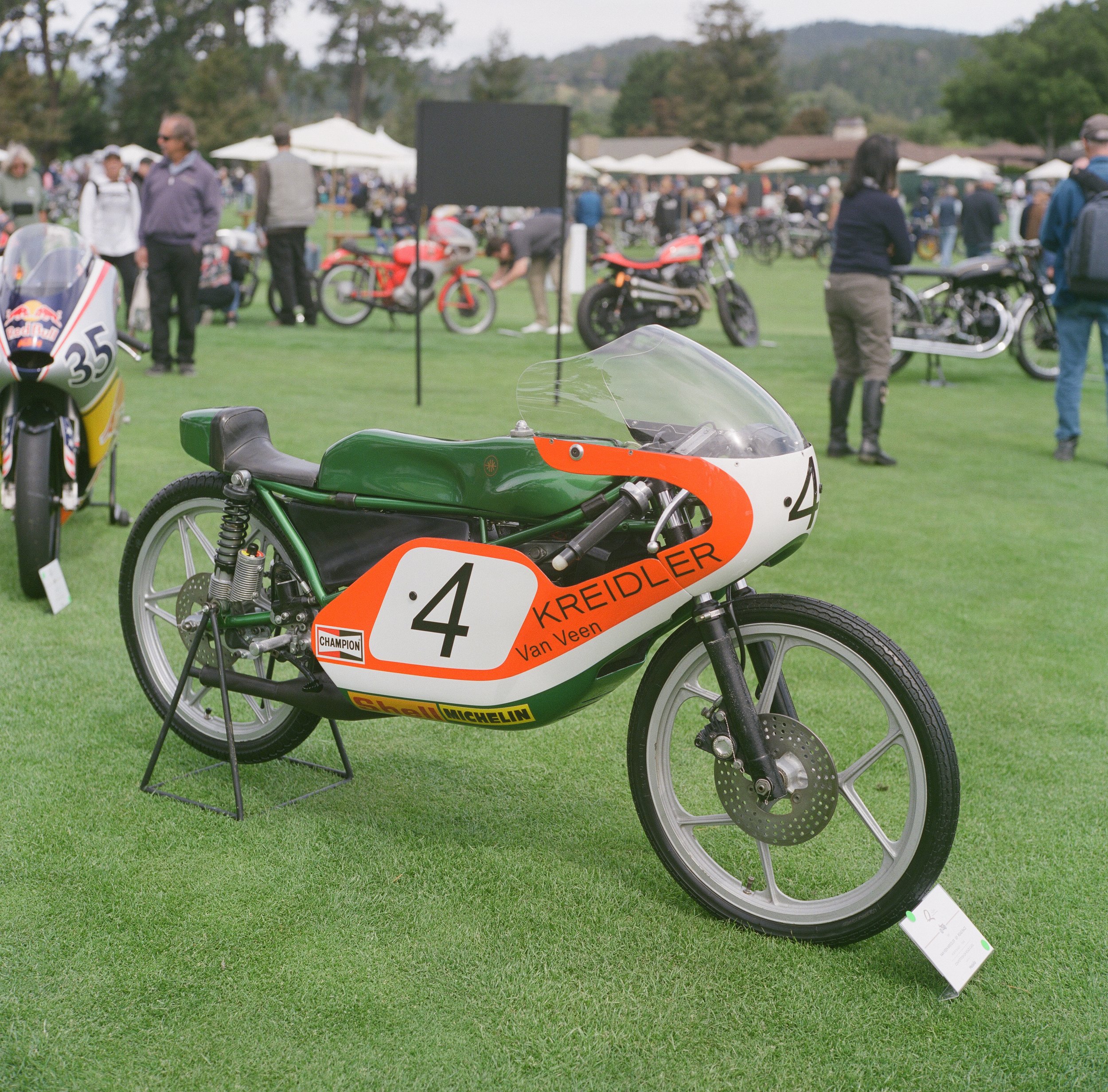
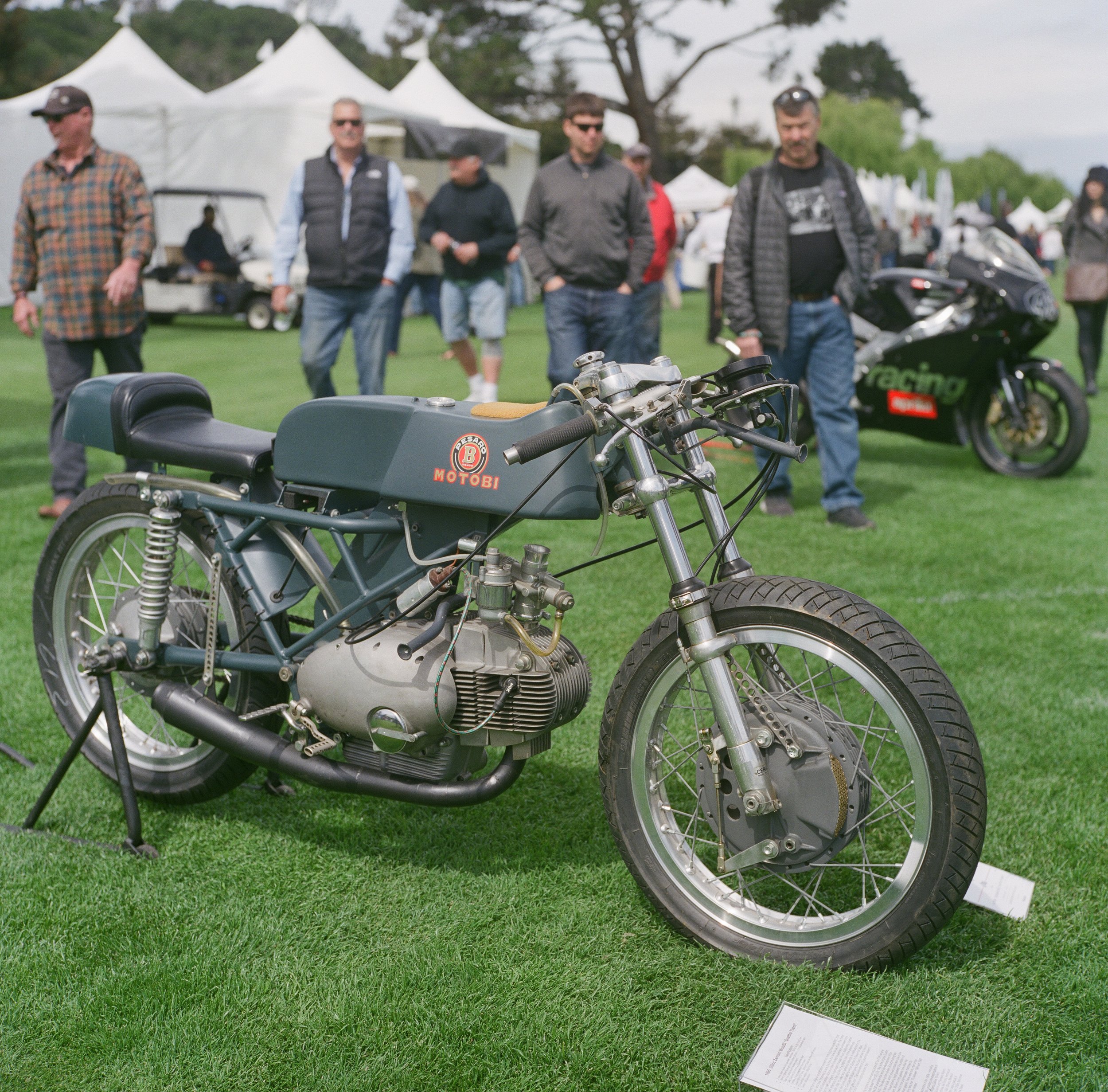
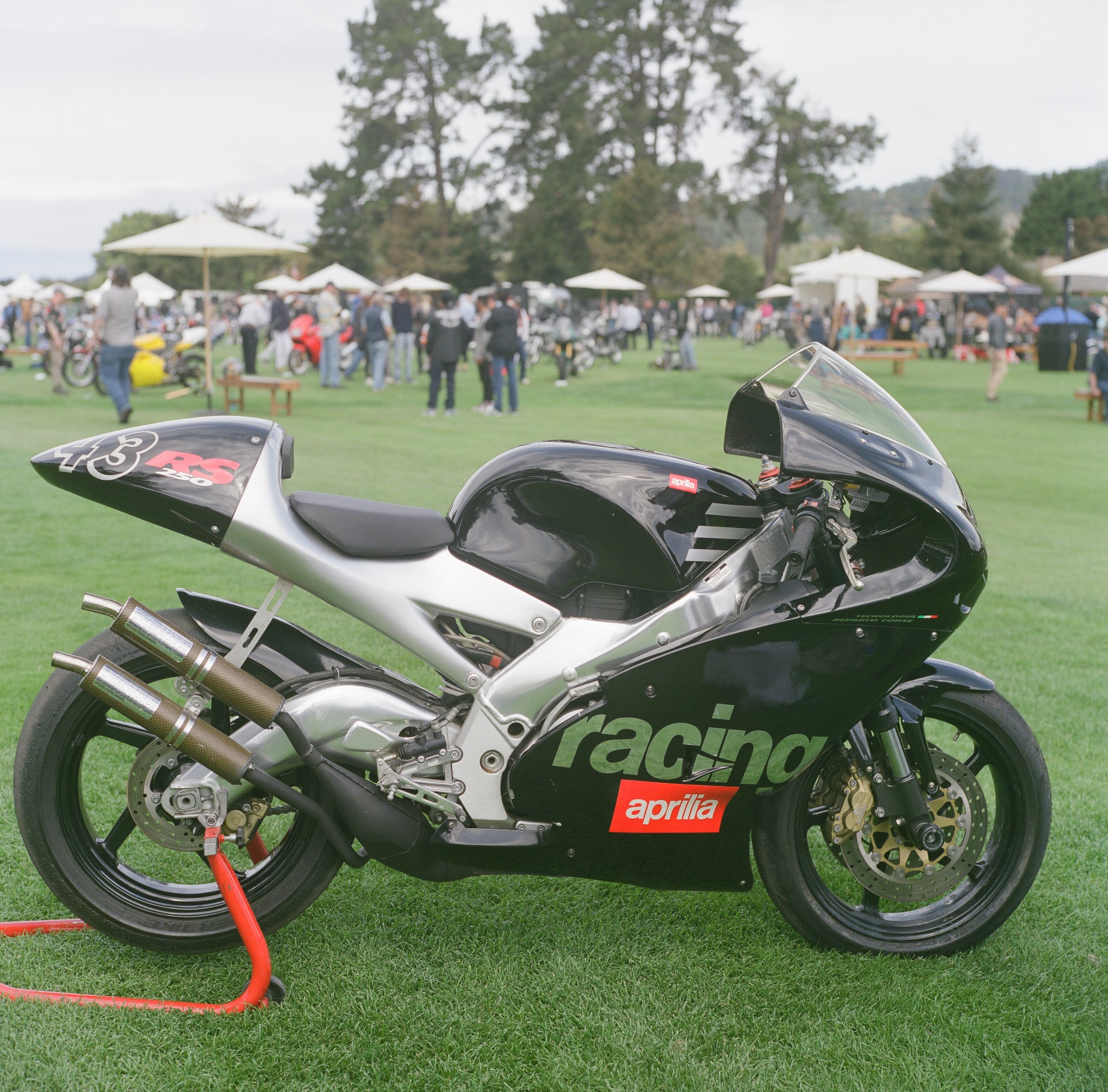
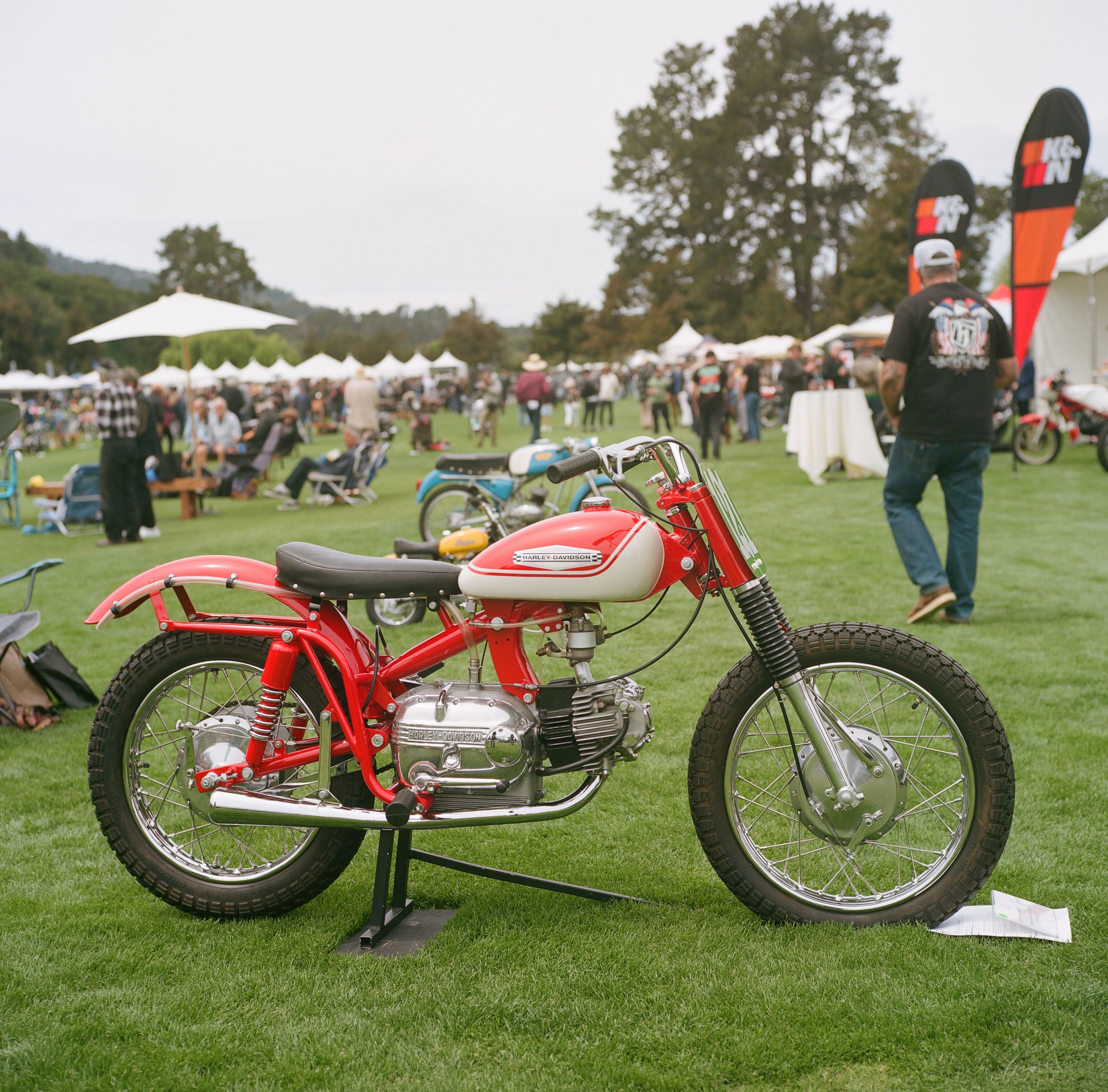

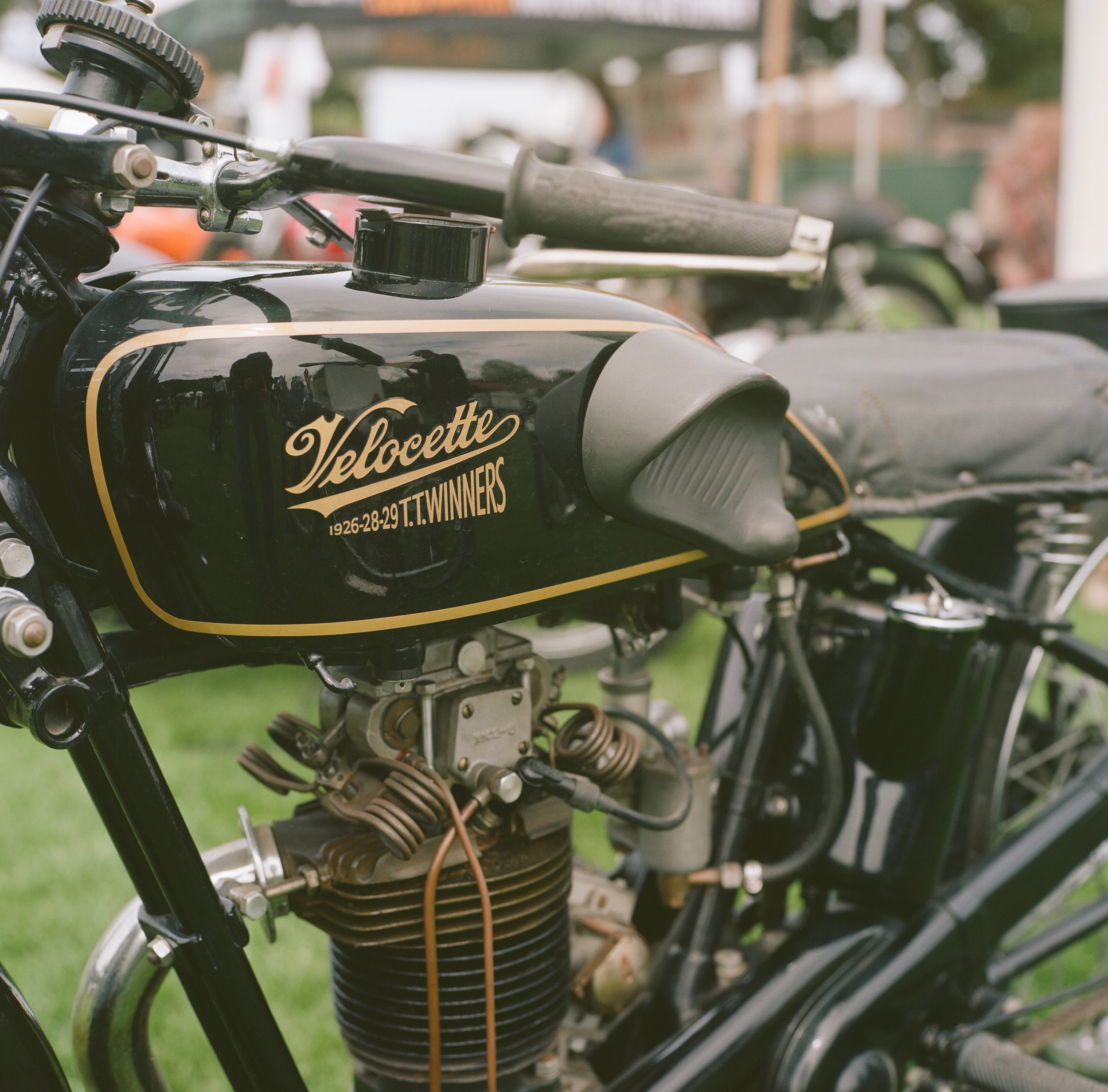
Above: A selection of competition machines gives a sense of the depth of the offerings on view.
Jerry judged the Off Road Competition class this year instead of his usual spot judging British machinery. This category was a little challenging because it encompassed everything from Bultaco dirt bikes to a Bonneville streamliner.
“We enjoyed the hell out of it,” said Jerry. “We were given our assignments and we ambled around and talked to the owners. We have our score sheet with categories: frame, engine, does it run etc.. Everyone had a different idea of what they liked but it’s all pretty friendly and all pretty fast. Eventually it all comes around and we have consensus. You just do the best you can.
“I believe just about everybody there would be qualified to be a judge. That’s the quality of folks in attendance…In general the numbers were down but I saw more stuff I’d never seen before at the Quail this year.”
The Competition Off Road class was won by Steve Poggi’s ’71 Bultaco M68 Pursang.
It’s all fairly congenial, After lunch the officials notify the winners and everyone gathers near the stage. Winners ride their bikes onto the stage and get interviewed by D’Orléans, often sharing some interesting and amusing stories about their bikes.
San Francisco-based collector John Goldman’s 1939 Miller-Balsamo took best of show honors. And well deserved.
The Best of show was won by John Goldman with his ultra-rare 1939 Miller-Balsamo two-stroke streamliner. “I got it from Torino,” said Goldman. “The body was more filler than aluminum. It took over 150 hours alone. It’s a 196cc but they call it a 200.” Goldman said there are three known examples of this model. It’s not surprising because it debuted in the teeth of the Second World War and it was expensive to make and not popular. With its all enveloping bodywork it had to be difficult to service. The bike was restored at the Zen House in Point Arena. You can see a clip of it running on YouTube at:
https://www.youtube.com/watch?v=beXcYdV1W2I
On an interesting, and totally irrelevant, side note Balsamo registered the Vespa name in 1934 and after the War Piaggio had to buy the name from them.
Goldman also won second place in the Antique class with his 1935 Motoconfort M5C. A French marque featuring Deco styling, a 500cc OHV single and sporting an amazing period Motul oil sticker on the tank.
Rob Fuller’s one-year-only ‘62 Vespa GS 160 took top scooter honors. The Grand Sport is arguably the top of the line for Vespa collectors and riders. With a long and successful racing history they have always commanded a premium.
One of the most beautiful machines was a one-year-only 1962 Vespa GS160 garage find survivor with only 1,200 miles on it. Only 136 examples of this model were sold in the States. The bike has fantastic original paint and still bears all the stickers that almost every owner took off upon taking possession, including the paper build stickers that are always missing. Owned by Rob Fuller and Megan Fun it twas the runaway winner for the Extraordinary Bicycles and Scooters award.
Robb Talbott’s immaculate 1956 Aero Capriolo Corsa 75 won the inaugural award for Italian and Single as well as the Spirit of the Quail award. Robb is the proprietor of the Moto Talbott Collection in Carmel Valley and a strong supporter of the event. Robb’s wife Vivienne picked out the little Capriolo at a sale, and a very astute choice it was.
Paul Murphy’s Seeley Honda is everything a ‘70s Brit Super Bike should be: loud and proud and in your face.
Not all of the winners were super-high-end museum pieces. Paul Murphy’s flamboyant ’78 Seeley/Honda 750 was the well deserved winner of the inaugural ‘70s Vintage Muscle award. It’s a bike he has owned for years. It has been rebuilt more than once as Murphy has put many miles on it touring and racing.
For some winners an award at the Quail is an acknowledgment of a lifetime of work. Others are old hands at the Winner’s Circle and return year after year.
The fantastic roads in the area are a big draw for riders. As a result a large number of attendees ride to the event and take part in the informal show that is in the motorcycle parking area. In some cases the bikes parked outside the event are as good or better than those inside. The popular online auction site Bring A Trailer was a sponsor this year and had a large display of very nice modern and vintage bikes on the lawn outside the event. Given the quality of bikes in their display I would not be surprised to see them with a large display inside the ropes next year.
For those of us who live in Northern California the Quail motorcycle Gathering is a chance to see old friends and make new ones. It is a cliche but the motorcycle game, be it collecting, riding or racing, is about the people you meet and the friends who are part of it. Looking forward to seeing you all next year.
This super-clean bobber was the unofficial Rust Magazine choice for best American Custom.
John Goldman’s ‘35 MotoConfort 500 won 2nd place in the Antique class.
A super sano Walt Siegl Duc.
One of my favorite bikes of the meet was this Seeley-Tait Yamsel brought by the Haas Motor Museum. A V-three two-stroke with DKW lines and showing amazing craftsmanship in the bodywork. I am unsure if, like the Deek, one of the cylinders acts as a compressor. To my eye only the front disc brake lets it down but that said I’m sure the extra stopping power is appreciated.
You can always tell a BMW rider. Hillary with her Bing carb-float earrings.
Czech Böhmerland in the Bring a Trailer compound.
Some ideas work and some don’t. But I’ll bet it was fun to try.
If you know you know.
Hmmmm, well, what do you think? The judges look over Robb Talbott’s Capriolo.
Nobody look at the spear.
Wayne Rainey tells the story of one of his first race bikes. His dad built the ‘71 Yamaha for himto race when he was 11. It won the AMA Hall Of Fame Heritage award.
Sharp enough to cut. Max Hazen built this dual-engined blown Velocette, which won the Custom/Modified award for Marco Diaz.
A bit of back story
The last two editions of the Quail that I have covered I used the trusted professional digital Nikon that I have used for the last few years. But when you cover an event a few times you want to try to find something new or take a new approach. It could be digging for a story that you missed the first time or maybe taking a new approach to writing style.
At first I thought that maybe I would take my sketch book and do the illustrations in watercolor and pen. In the end I chickened out on that tack and decided to shoot film with some of my old cameras. However, I suspect the sketch book is an idea that may win out in some future story. I decided I would take photos of old motorcycles with old cameras, a concept that several people verbalized over the course of the day.
It is somewhat astonishing the degree to which an old camera acts as an icebreaker. Especially with people who are attuned to old machinery. Plus it is a bit out of the ordinary so it draws attention. People remember the cameras they, or their parents, used to use with affection. More than one person came up to me and said, “I used to have one of those; that is so neat.”
The main camera I used was a 1952 Rolleiflex, which was the professional standard in its day and still very hard to beat as a professional tool 70 years later. They really don’t make them like they used to. The photos in this article that are square were shot with the Rollei. If you look at old photos of the racing paddocks you will see a lot of Rolleiflex cameras. The film “La Dolce Vita” is chock full of Rolleiflex.
I also brought along a 1964 Nikon F to make use of the telephoto to shoot some 35mm film. Unfortunately some of the film I brought, Kodak Ektar 125, proved to be bad and all the photos on that roll came out green like they were shot in a pond. C’est la vie! The other roll came out great.
Photographers laugh about how we used to take 100 or so photographs when shooting something like this on film. Now I would routinely make 1,000 or 2,000 photographs covering an event with my digital camera. But are they all better? Having fewer exposures tends to make you look a bit more intentionally. Not all of those shots are good or useable, that’s for sure. But if you have the storage, what the hell, it doesn’t cost anything and digital storage is cheaper than shoe leather, so that’s how you end up with 2,000 photos to edit.
A bonus to old cameras is the spur to creativity that imposing a restriction brings about. The Rollei takes 12 exposures to the roll and you cannot change the lens. So you have to work. All your flaws and mistakes are highlighted. Mea culpa: I did notice when the film came back that I pull the camera slightly to the right when releasing the shutter. So that is something to keep in mind in the future.
Film has a different look than digital, so that is a difference in the photos. Color film does not render reality accurately. Even the best of it is (or was) an interpretation of reality. That is not to say it’s bad, just that it has a “look” of its own.
With digital, there is a certain sense of confidence that you will end up with something good because you can look at what you shoot as you take it and not have to worry that you got the exposure correct.
All in all it was a successful experiment. In the future I will do a hybrid approach and mix digital and film. After all, it’s nice to have something concrete like a negative for when the power goes out.
I did something else different this year. In past years I rode one of my motorcycles or scooters to the event, but this year I decided to take advantage of the proximity of my digs and rode my 1951 Schwinn straight-bar Klunker, which delivered fantastic riding on the back trails along the Carmel River between Quail lodge and the pad as well as easy and swift access to the event.
Heresy you say? Eh, I think not. Two Wheels forever!





